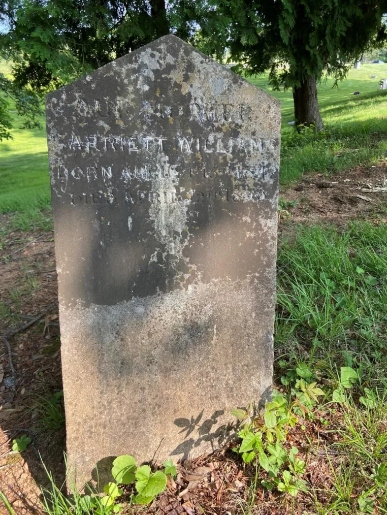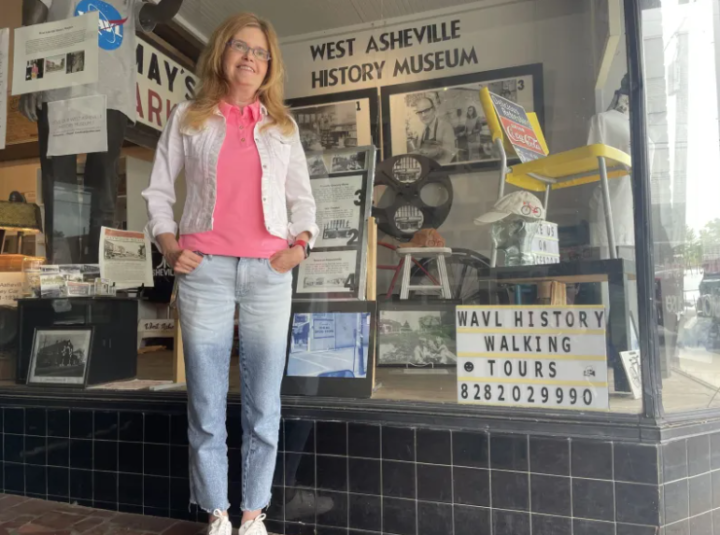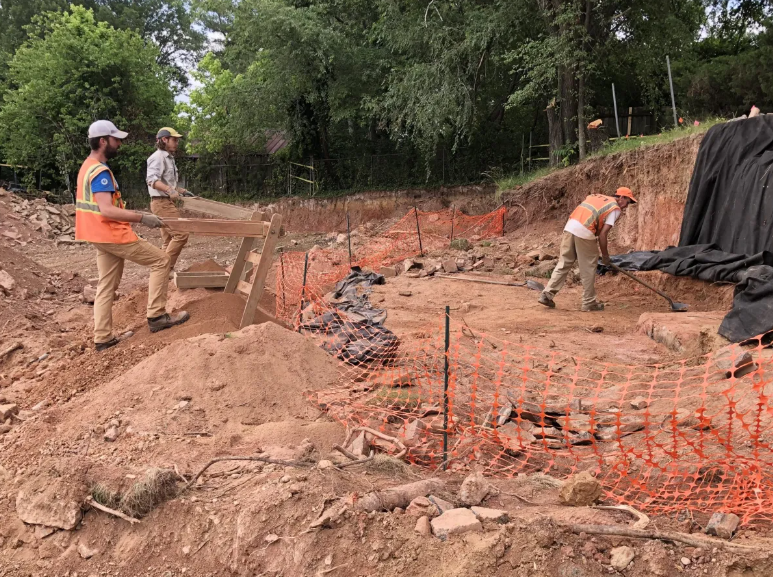by Andrew R. Jones, avlwatchdog.org
Human remains found at a West Asheville construction site on Haywood Road likely belong to former slaves and parishioners of a culturally and historically significant African American church, according to recent archaeological research.
It is unclear how many sets of remains could be there, Tasha Benyshek, senior archaeologist with cultural resources management firm TRC, told Asheville Watchdog. Wilson Chapel A.M.E. once stood on the site before it moved in 1925, according to a draft report of her research obtained by The Watchdog.
“I can find no records of how many people were buried at Wilson Chapel,” she said. “We have absolutely no idea. It could be 10. It could be 100.”
Her firm was hired by the site’s developer after the location was found to be potentially historically significant and after years of pressure from an amateur sleuth.
A parking lot near the site, which is across the street from the West Asheville Presbyterian Church, is off limits for development because it may be part of the church’s cemetery. Archaeologists may perform ground sonar work to determine if there are more remains but will not dig further, Benyshek said.
All remains were supposed to be removed when the congregation moved to Burton Street, where the church was eventually renamed Community Baptist Church.
Calvin Hailstock has been pastor there for about 14 years.
“We pray that the bodies that were in the parking lot have already been moved,” Hailstock said. “Wilson Chapel goes back over 125 years, and that’s still our family.”
The discovery, which Hailstock assumes includes parishioners who had ancestors at the Wilson Chapel cemetery, is double-edged for the church.
“Yes, we’re disappointed. I want to make sure that is noted,” Hailstock said, discussing the years people suspected that the site was likely a cemetery but didn’t seriously pursue more comprehensive archaeological research. “But the only thing we can do now is redeem.”
Redemption, Hailstock said, means memorializing the site and remembering the names lost to history.
“I think that there ought to be a redemptive action to make sure that it is honored correctly, so that we can heal and not be angry,” Hailstock said.
He added it was likely that not everyone buried at the Wilson Chapel cemetery was a parishioner there. “It could have been anybody in the African American community that never stepped foot into Wilson Chapel, or never was a member of Wilson Chapel, because we were about community,” he said. “It’s broader than Wilson Chapel.”
But there is no doubt that some people buried at the site were enslaved.
“Certainly there were formerly enslaved people buried there,” Benyshek said. Her research for TRC notes Wilson Chapel “was established not long after emancipation,” which “ensures that it was, or is, the resting place for formerly enslaved people.”
Harriet Williams is one woman who may have been buried at Wilson Chapel, according to the draft of TRC’s archaeological report. Her funeral was held there, according to 1890 newspaper records cited in the report.
Williams “was a highly respected, industrious and saving woman” who lived by herself in a small western Asheville home, according to an Asheville Weekly Citizen newspaper report in 1890. Her mother and father were Sandie and Leah Erwin. Williams was a boarder who did washing and ironing.

Today Williams is interred in the southwestern part of Green Hills Cemetery in what was once a segregated African American section.
According to the Weekly Citizen, Williams was once enslaved by Zebulon Vance, former North Carolina governor, U.S. senator and the namesake of numerous Western North Carolina landmarks and a toppled monument in downtown Asheville. Williams was murdered by someone with an axe, according to newspaper reports from 1890.
Wilson Chapel was active for at least 35 years, according to TRC’s draft report. The land itself was deeded to church trustees in 1888 but could have been used as a church as early as 1883.
But details about the original Wilson Chapel site, according to TRC research, remain scant. TRC didn’t find church or cemetery records. The Western North Carolina Conference of the United Methodist Church archives did not have material related to the chapel. There are no survey plats of the tract aside from those created for current development, though there are references to the church in old maps.
When the church moved, so did at least a portion of its cemetery, according to the TRC report. It is not clear how many interred people were moved then.
“It was the responsibility of the church to move the graves,” Benyshek said.
Before the remains were found last week, according to the TRC research, oral histories hinted at the possibility of gravesites. Coffin hardware was also found in the area last week.
A mystery in her backyard
Since she was a teen, Conda Painter and her father Richard had a hunch about the backyard and surrounding area of their Nevada Avenue home.
“When we were putting it together we didn’t have the proof,” she said. “Now we have the proof.”
Painter spent decades puzzling over historical records, photos, newspaper clippings, and even bits and pieces of what she now knows to be a coffin. Painter and Benyshek, who have collaborated on the project for years, say there were no detailed records related to the church or its cemetery, only passing references.
“There’s no listing of things,” Painter said. “It was just kind of ignored.”
Not everyone’s recollection of the cemetery had faded, however. People in the neighborhood in their 80s and 90s told Painter they thought people were buried there.
“I interviewed quite a few neighbors and one neighbor who was in his 90s, he said he lived in the house that’s real near the corner of the backyard,” Painter said. “He said he remembers being like five or six years old hearing a wagon going up behind the house and taking a coffin. He said he always had nightmares about that.”
An African American man arrived at her home one day when she was young, Painter remembered. He said, “I’m looking for my great grandmother. Is there any chance that there’s been a cemetery up between one of these houses?”’ Painter said.
“I thought, ‘Wow,’ and I didn’t get his name at the time, and to this day, I wished I knew that guy’s name.”
Painter’s efforts in 2006 were documented in a Mountain Xpress article, which pushed for an investigation of her backyard.
Benyshek was featured in that piece, which detailed her archaeological work. But she found no remains then.
When the city of Asheville approved development in 2021 at the lot near where Painter believed the cemetery was concealed, she shared the article on social media. State archaeologists visited the site that year. Development Services Director Ben Woody sent a letter to developers describing the visit.
“The purpose of this onsite visit was to meet with a representative of the North Carolina Office of State Archaeology to examine a property that may have been the historic location of Wilson Chapel A.M.E. Church and cemetery prior to its removal in 1925,” Woody wrote.
But then nothing happened.
“They put the brakes on it two years ago, and it’s just been sitting there,” said Painter.
The Watchdog left a message with the state archaeology office in Asheville seeking information about the delay but did not immediately hear back.

Two months ago, Benyshek and a TRC team were contracted by the developer and returned to the site, looking in earnest for remains as workers dug foundations for the planned development.
“I started the study in earnest when it was clear we would be hired to conduct the work just short of two months ago and have worked on it when I had the time,” Benyshek said. “Until new development was planned, there was no one to look into the possibility that graves were still located on the property. When there were new development plans, the city could require the developer to do the study.”
The developer, Imran Alam of Reevan LLC, was unaware of the tract’s history, Benyshek said. “He has been incredibly patient and supportive.”
Alam bought the property about three years ago, he said, and planned to put a gas station there. When the city didn’t approve of that, he tried a retail center. As development of the site moved forward, part of it was cordoned off for the state’s archaeological study.
Alam recalled the moment last week when development suddenly stopped.
“I was standing with the architects and the engineers and she (Benyshek) brought me those bones. We stopped everything,” Alam said. Forensic police and a medical examiner arrived, he said, and the men working on the site became upset by their discovery.
The discovery and his conversations with archaeologists – a jolting reminder of slavery in America – initially unnerved him, Alam said.
“I thank God that we’re not living in that age,” he said.
“It was a shock,” Painter said, describing the moment workers found the first bones on the site. “I knew it was there, but actually seeing it was pretty breathtaking.”
The bones and coffin hardware were respectfully put back in the earth where they were found, said Alam, Painter, and Benyshek.
As Benyshek prepares her report, which will be sent to Alam and the city, Painter said she feels like years of work have paid off.
“It was a feeling of closure,” she said. “It’s like, the mystery is solved.”
Asked how she thought the Wilson Chapel cemetery saga relates to the erasure of African American history and culture after the Civil War, Painter said she felt like there was a connection.
“To be honest, I feel like that is probably why it may have got just kind of pushed under the rug,” she said.
‘Let the people rest’
Benyshek gives Painter full credit for bringing the cemetery out of obscurity.
“Conda Painter is to be credited completely for making sure the story of the Wilson Chapel cemetery was not forgotten,” Benyshek said.
Everyone involved wants to establish a way to turn the site into some sort of historical marker.

Alam said that if anyone finds they had ancestors who may be buried there they should contact him. “Otherwise, we have a plan to donate that area of land and will put monuments and preserve it with an engineered retaining wall,” Alam said.
Painter said she wants to start a GoFundMe for a monument to the nameless interred.
City of Asheville Interim Director of Development Services Mark Mhany said collaboration has been vital to the project.
“The current archeological/historical investigation is a real-time example of the City of Asheville and private owners/developers working together to maintain, safeguard and honor our City’s history and culture,” Methany said. “Both the City and owner Imran Alam took neighborhood concerns for local history seriously. You can recognize that in the conditions of the permit, that an archaeologist be on site throughout the project, and the owner’s willingness to meet those conditions.”
Hailstock hopes a historical marker will be placed on the site in such a way that it can be “seen and not an afterthought.”
Asked if he was angry that the remains and names were lost to history and the slow creep of development over more than a century, Hailstock said his feelings are more complicated.
“I think there’s hurt. Anger is another level,” he said. “I want to believe that no one would intentionally do it. With that belief, since the mistake has been made, I think that there ought to be redemptive action.”
Hailstock said he’s pleased that archaeologists would not continue to dig at the site.
“Let the people rest,” Hailstock said. “Let the people rest, but honor their place.”
Asheville Watchdog is a nonprofit news team producing stories that matter to Asheville and Buncombe County. Andrew R. Jones is a Watchdog investigative reporter. Email arjones@avlwatchdog.org. To show your support for this vital public service go to avlwatchdog.org/donate.





Before you comment
The comments section is here to provide a platform for civil dialogue on the issues we face together as a local community. Xpress is committed to offering this platform for all voices, but when the tone of the discussion gets nasty or strays off topic, we believe many people choose not to participate. Xpress editors are determined to moderate comments to ensure a constructive interchange is maintained. All comments judged not to be in keeping with the spirit of civil discourse will be removed and repeat violators will be banned. See here for our terms of service. Thank you for being part of this effort to promote respectful discussion.